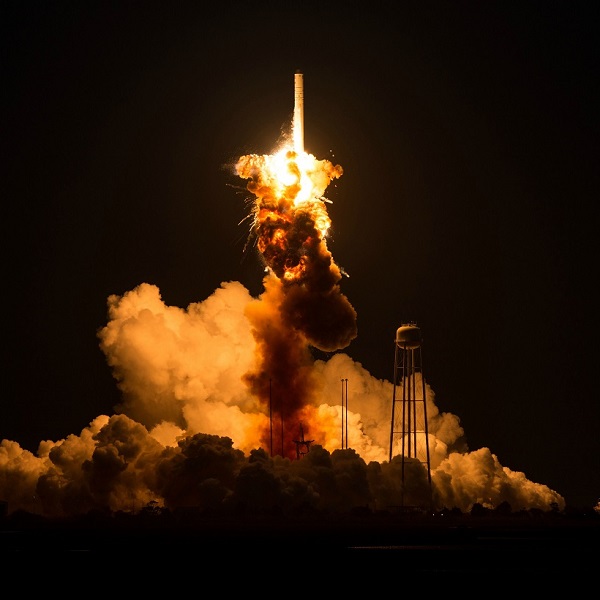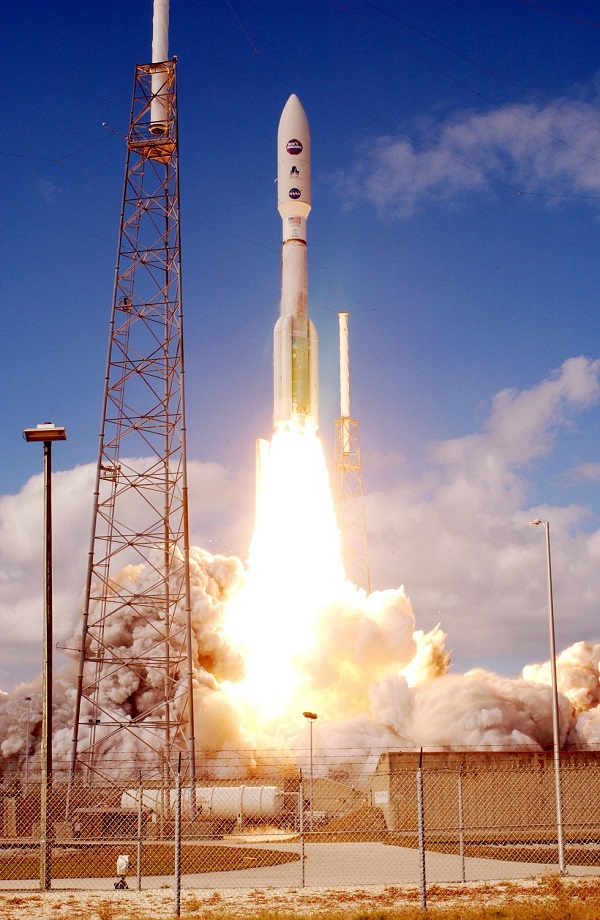 |
| Credits: NASA/Joel Kowsky |
Orbital’s statement regarding the ORB-3 launch mishap:
(Dulles, VA 28 October 2014) – Orbital Sciences Corporation (NYSE: ORB), one of the world’s leading space technology companies, confirms that today’s Antares rocket launch from NASA’s Wallops Flight Facility was not successful. Shortly after lift-off from the Mid-Atlantic Regional Spaceport Pad 0A at 6:22 p.m. (EDT), the vehicle suffered a catastrophic failure. According to NASA’s emergency operations officials, there were no casualties and property damage was limited to the south end of Wallops Island. Orbital has formed an anomaly investigation board, which will work in close coordination with all appropriate government agencies, to determine the cause of today’s mishap.
“It is far too early to know the details of what happened,” said Mr. Frank Culbertson, Orbital’s Executive Vice President and General Manager of its Advanced Programs Group. “As we begin to gather information, our primary concern lies with the ongoing safety and security of those involved in our response and recovery operations. We will conduct a thorough investigation immediately to determine the cause of this failure and what steps can be taken to avoid a repeat of this incident. As soon as we understand the cause we will begin the necessary work to return to flight to support our customers and the nation’s space program.”
Orbital will provide more information as it becomes available and is verified.
Orbital’s update on October 29:
Early this morning, range officials performed an aerial survey of the launch facilities and surrounding areas at NASA’s Wallops Flight Facility where yesterday’s failure of the Antares rocket occurred after it lifted off from the Mid-Atlantic Regional Spaceport’s Pad 0A. Shortly after, a team of representatives from NASA, MARS and Orbital entered the launch site to perform a preliminary assessment of the launch complex and related facilities. The overall findings indicate the major elements of the launch complex infrastructure, such as the pad and fuel tanks, avoided serious damage, although some repairs will be necessary. However, until the facility is inspected in greater detail in the coming days, the full extent of necessary repairs or how long they will take to accomplish will not be known.
NASA has posted aerial views of the launch pad taken earlier today here.
Also today, Orbital made progress forming a permanent Accident Investigation Board (AIB) comprised of company officials, along with representatives from NASA and the NTSB, with the FAA providing overall oversight of the process. Initially, Mr. Rich Straka, Senior Vice President and Deputy General Manager of Orbital’s Launch Systems Group, served as the interim chairman to begin the investigation process immediately after the launch mishap. Today, Orbital appointed Mr. Dave Steffy, Senior Vice President and Chief Engineer of the company’s Advanced Programs Group, a highly experienced engineer well-versed in launch vehicle engineering and operations, to serve as the permanent chairman of the AIB.
No follow-on press conferences are planned at this time. Further updates on the situation and the progress of the ongoing investigation will be provided as they are available.
Orbital’s update on October 30:
Launch Site Status:
Based on initial sweeps conducted by an Orbital safety team, it appears a significant amount of debris remains on the site and it is likely substantial hardware evidence will be available to aid in determining root cause of the Antares launch failure. Some of the Cygnus cargo has also been found and will be retrieved as soon as we have clearance to do so to see if any survived intact. After up close visual inspections by the safety team, it still appears the launch site itself avoided major damage. There is some evidence of damage to piping that runs between the fuel and commodity storage vessels and the launch mount, but no evidence of significant damage to either the storage vessels or launch mount. Detailed evaluations by MARS and their engineering team will occur in the next couple of days. An Orbital-led team has begun cataloging and documenting the location of all pieces of debris over the next several days after which the debris will be relocated to storage bays on the island for further evaluation.
Antares Data Review:
Telemetry data has been released to Orbital and our engineers presented a very quick look assessment to the Accident Investigation Board at the end of the day. It appears the Antares vehicle had a nominal pre-launch and launch sequence with no issues noted. All systems appeared to be performing nominally until approximately T+15 seconds at which point the failure occurred. Evidence suggests the failure initiated in the first stage after which the vehicle lost its propulsive capability and fell back to the ground impacting near, but not on, the launch pad. Prior to impacting the ground, the rocket’s Flight Termination System was engaged by the designated official in the Wallops Range Control Center.
Orbital’s update on November 3:
Over the weekend, Orbital confirmed the participation of the following individuals who will serve on the Antares launch failure Accident Investigation Board (AIB), which is being led by Orbital under the oversight of the Federal Aviation Administration (FAA). The composition of the AIB is as follows:
Chairman: David Steffy, Chief Engineer of Orbital’s Advanced Programs Group.
Members: David Swanson, Senior Director of Safety and Mission Assurance for Orbital’s Technical Operations organization; Wayne Hale, Independent Consultant and Former NASA Space Shuttle Program Manager; David Cooper, Member of Orbital’s Independent Readiness Review Team for the company’s Launch Systems Group; Eric Wood, Director of Propulsion Engineering for Orbital’s Launch Systems Group; Tom Costello, Launch Vehicle Assessment Manager in the International Space Station Program at NASA’s Johnson Space Center; Matt Lacey, Senior Vehicle Systems Engineer for NASA’s Launch Services Program.
FAA Oversight Team: Michael S. Kelly, Chief Engineer, FAA Office of Commercial Space Transportation; Marcus Ward, Mishap Response Coordinator, FAA Office of Commercial Space Transportation.
Antares Data Review:
The AIB is initially focused on developing a “fault tree” and a timeline of the important events during the launch sequence. Due to the large amount of data available, the AIB is able to work with a rich source of information about the launch. One of the initial tasks for the AIB is to reconcile the data from multiple sources, a process that is now underway, to help create the launch sequence timeline.
Launch Site Status:
Over the weekend, Orbital’s Wallops-based Antares personnel continued to identify, catalogue, secure and geolocate debris found at the launch site in order to preserve physical evidence and provide a record of the launch site following the mishap that will be useful for the AIB’s analysis and determination of what caused the Antares launch failure. The debris is being taken to a NASA facility on Wallops Island for secure and weather resistant storage.











 Subscribe to blog posts using RSS
Subscribe to blog posts using RSS










